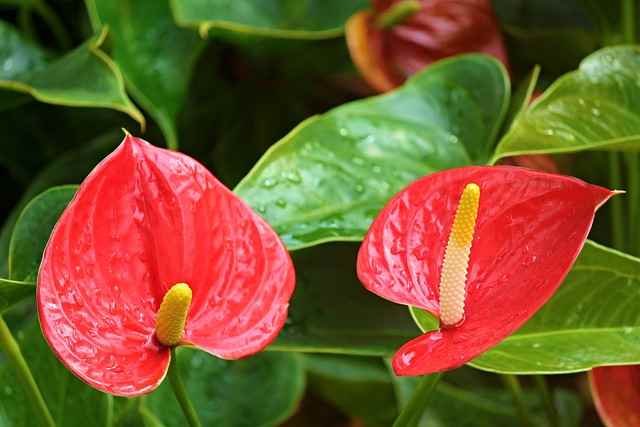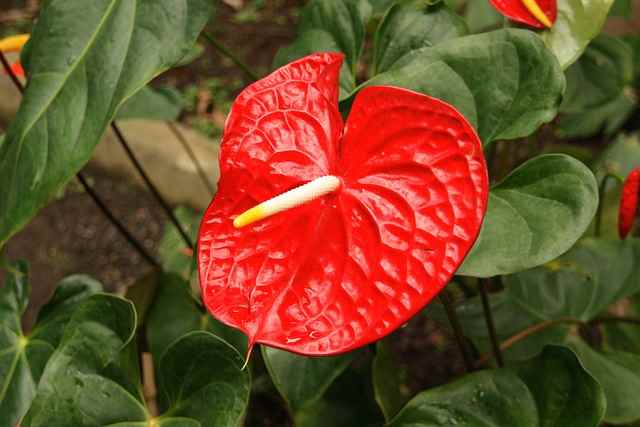The Red Peace Lily Plant, also known as Anthurium, is a popular indoor plant in India that is prized for its striking appearance and easy care requirements.
As the name suggests, this plant is a member of the Peace Lily family, but it is distinguished by its bright red flowers and dark green leaves.
The Red Peace Lily Plant is a compact plant that typically reaches a height of 12 to 18 inches, making it an ideal choice for small spaces such as apartments, offices, or dorm rooms.

Its foliage is glossy and rich green in color, and it produces deep red spathes (the modified leaves that surround the flowers) that bloom periodically throughout the year.
One of the benefits of the Red Peace Lily Plant is that it is relatively low-maintenance indoor plant. It prefers bright, indirect light but can also tolerate lower light conditions, making it an excellent choice for indoor environments. It thrives in well-draining soil that is kept consistently moist, but it can also tolerate periods of drought if necessary.
Additionally, it is known for its air-purifying properties, making it an excellent choice for improving indoor air quality.
It can help remove harmful pollutants such as benzene, formaldehyde, and carbon monoxide from the air, making it a healthy addition to any indoor environment.
Overall, the Red Peace Lily Plant is a beautiful and easy-to-care-for plant that can add a touch of color and life to any indoor space.
In this article, you will learn about how to care for it properly.
Red Peace Lily Plant Care: Everything You Should Know

Light:
The Red Peace Lily prefers bright, indirect light. It can also tolerate low light conditions, but the leaves may turn a lighter green if the plant does not receive enough light. Avoid placing the plant in direct sunlight, which can cause the leaves to burn.
Water
Watering is an important aspect of Red Peace Lily care. The plant prefers to be kept consistently moist, but not wet. Over-watering can lead to root rot, so it is important to make sure that the soil is not waterlogged. The best way to determine if the plant needs watering is to stick your finger into the soil. If the top inch of soil is dry, it is time to water.
Red Peace Lily Plant Leaves Turning Brown
There can be many reasons for the leaves to turn brown which includes:
- Watering Too Much (Overwatering) which causes root rot and the leaves start to turn brownish.
- Low humidity
- Nutrient Deficiency – Check fertilizers for flowering plants
- Exposure to Direct Sunlight for prolonged period.
You will need to analyze it yourself as to what might be the cause and rectify it. If you need help in figuring it out then make sure to comment down.
Soil
The Red Peace Lily prefers a well-draining soil mixture. A mixture of peat moss, perlite, and vermiculite works well. The plant should be planted in a pot with drainage holes to prevent the soil from becoming waterlogged.
Humidity:

The Red Peace Lily is a tropical plant and prefers a humid environment. If the air in your home is dry, you can increase the humidity around the plant by placing a tray of water near the pot, or using a humidifier.
Fertilizer:
The Red Peace Lily does not require a lot of fertilizer, but it can benefit from regular feedings. A balanced, water-soluble fertilizer should be applied every two weeks during the growing season (spring and summer). In the winter, it is best to reduce fertilizing to once a month.
Check out – Best Fertilizer for Flowering Plants in India
Pruning:
Pruning is essential for maintaining the shape of the Red Peace Lily and removing yellow or damaged leaves. The plant can be trimmed back to its desired height, but it is best to only remove a third of the plant at a time to avoid shock.
Re-potting:
The Red Peace Lily should be re-potted every two years to ensure that the plant has enough room to grow. Re-potting should be done in the spring, just before the growing season begins. When re-potting, choose a pot that is one size larger than the current pot and use a fresh, well-draining soil mixture.
Pests and Diseases:
The Red Peace Lily is generally pest-resistant, but it can be susceptible to spider mites and scale insects. To prevent infestations, it is important to regularly inspect the plant for signs of pests and to treat them promptly if detected.
In addition to its attractive appearance and ease of care, the Red Peace Lily is available in a variety of cultivars. Some popular cultivars include:
- Spathiphyllum ‘Mauna Loa’: This cultivar has large, dark green leaves and white, boat-shaped flowers. It is a fast grower and can reach up to 3 feet tall.
- Spathiphyllum ‘Clevelandii’: This cultivar has deep green leaves and white flowers that are larger than those of other cultivars. It is a compact plant, growing to about 2 feet tall.
- Spathiphyllum ‘Wallisii’: This cultivar has dark green leaves with a red tint and large, white flowers. It grows to about 2 feet tall and is a slow grower.
- Spathiphyllum ‘Sensation’: This cultivar has green leaves with a red tint and large, white flowers that are heavily spotted with red. It is a slow grower, reaching up to 2 feet tall.
- Spathiphyllum ‘Mauna Kea’: This cultivar has green leaves with a red tint and large, white flowers. It is a fast grower, reaching up to 3 feet tall.
Final Words:
No matter which cultivar you choose, all Red Peace Lilies are easy to care for and make great houseplants. If you are looking for a plant that will purify the air and add a touch of beauty to your home, consider a Red Peace Lily. With proper care, these plants will thrive and provide years of enjoyment.
In conclusion, the Red Peace Lily is a beautiful and low-maintenance plant that is ideal for improving indoor air quality. With proper care, it can thrive and provide years of enjoyment.
Keep in mind that the plant prefers bright, indirect light, moist but well-draining soil, and a humid environment. Regular watering, fertilizing, pruning, and re-potting will help to ensure the health and longevity of your Red Peace Lily.




